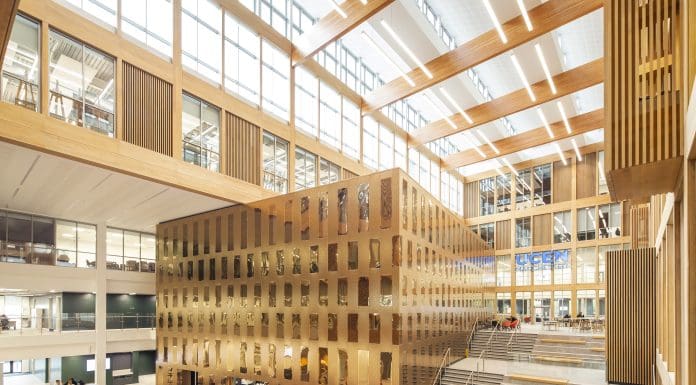Tasked with creating a state-of-the-art city centre campus for further and higher education, Bond Bryan and Simpson Haugh delivered a distinctive and inspirational learning environment for the Manchester College and UCEN using an Archicad model
The collaborative nature of the project meant that the architects, engineers and specialist consultants worked in their preferred software with everything coordinated via IFC.
This meant the designs were brought together from a combination of Archicad, Revit, Vectorworks, Navisworks and 2D files, coordinated using Solibri.
Responsible for the external design and the main atrium space, Simpson Haugh modelled in Revit. Meanwhile, Bond Bryan works in Archicad and was responsible for the internal massing of the college.
Brad Stenson, chartered architectural technologist at Bond Bryan, explains the process: “When we started working together, some of the other consultants using different software were unsure of whether they would be able to coordinate with an Archicad model. But it didn’t hold us back at all – everything went very smoothly.
“Many people who are used to Revit don’t know how advanced Archicad is for working with other software. In fact, it’s very straightforward to import IFCs directly into Archicad.
“Before joining Bond Bryan, I had more than four years’ experience of working with Revit – but I definitely prefer working with Archicad now.”
Taking inspiration from industrial heritage
Inspired by classical courtyard buildings, the bespoke timber-clad atrium creates a fresh and welcoming central hub for the college punctuated by the Jewel Box theatre and restaurant area at its centre.
The external façade takes its inspiration from Manchester’s industrial heritage, with a nod towards the patterns and textures of textile weaving reflected in the brick façade. A modular pattern of windows and masonry alternate on each level, enhancing the weave appearance.
Meanwhile, full-height vertical windows offer maximum daylight penetration, while extensive glazed curtain walling at the lower floors provides a ‘shopfront’ for the college, offering views into the building while also animating the streetscape.
Streamlining design and avoiding errors with Archicad model
Several features within Archicad helped to speed up the technical design process and ensure accuracy within the model.
The graphic overrides meant it was easy to distinguish between different elements of the design that looked very similar.
“A striking design feature in the internal atrium space is a timber colonnade which is made up of multiple different columns and beams which were individually crafted,” says Brad.
“We used the graphic override to colour code these, which meant we could easily see how many of each type of column or beam there was. It made it much easier for the carpenter to understand and prevented any costly mistakes.”
Archicad’s composite tool also saved the design team significant time.
“With the composite tool, once we’ve created the build once, and we change one element, for example the thickness of the insulation, it automatically updates throughout the model,” says Brad.
Virtual reality for client immersion
“Our clients really like Graphisoft’s BIMx and often ask for BIMx files to help visualise the designs,” explains Brad.
“For the Manchester College, we exported the design as a BIMx file and used a VR headset to virtually stand in the main atrium space.
“Prior to this exercise, many people couldn’t visualise the scale of the building. This virtual reality approach really helped everyone to understand how the building would look.”
Delivering BIM data for construction
The first phase of the campus was constructed with a steel frame.
“We worked closely with the manufacturer and in addition to IFC, shared information via mark-ups and comments on drawings on areas such as the stairs so they could easily see the top of the steel heights,” says Brad.
“In addition, Bond Bryan worked on the construction site one day a week throughout the build. This enabled us to oversee the work and ensure everything was built to specification. In addition, it meant any queries from the contractors could be answered straight away.”
Once the building was completed, Bond Bryan handed over design information in the form of DWGs, IFCs and the BIMx model, all extracted directly from the Archicad model.
Graphisoft UK
Tel: +44 (0) 1895 527590
Please note: This is a commercial profile
The post Collaborative nature of Archicad model brings city campus to life appeared first on Planning, Building & Construction Today.


